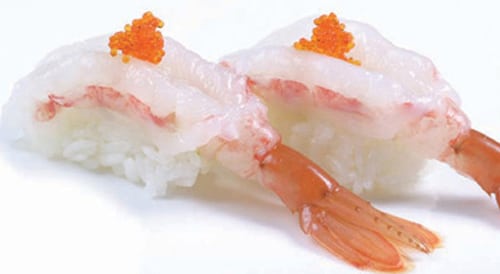
Only ten percent of the global shrimp market is sourced from the Atlantic Ocean and the Gulf of Mexico, but they remain important areas for the global ebi and ama-ebi market. The Gulf of Mexico region is important for consumers who wish to have seafood sourced in a manner with stricter consumer regulations than the other 90% of the shrimp market, which originates mostly from Southeast Asia and South America. The Gulf of Mexico is home to four native species of shrimp, including brown shrimp, white shrimp, pink shrimp, and rock shrimp. The native species are currently being threatened by Giant Tiger Prawns (Penaeus Monodon), which are the largest, most virile species of shrimp in the world. These tiger-striped monstrous shrimp can be over a foot long, and can spawn up to a million eggs at a time.
How did these shrimp travel the vast distances between their native habitat and the Gulf of Mexico? There are many theories, some more far flung than others. One possibility is ballast water. Cruise ships, tankers, and cargo carriers use enormous amounts of ballast water in order to give stability to the ship when crossing vast oceans. Ballast water discharge can contain viruses, bacteria, non-native plants, and, in the case of Gulf of Mexico, most likely some unwanted hitchhikers in the form of the foot long tiger prawns.
Ever heard of frogs raining down from the sky? While it might seem crazy, it is possible that hurricanes transported tiger prawns from South America, where the shrimp are farmed, to the Gulf of Mexico. Hurricanes Earl and Irene took paths in 2010 and 2011 respectively which could have potentially carried the shrimp into the Gulf, or, more probably, simply damaged and destroyed shrimp farms allowing the species to escape into the wild in vast numbers. While this is one of the most unlikely theories as to how Giant Tiger Prawns found their new home in the Gulf of Mexico, it does raise a very valid concern as to the impact of fish farming. Even with non-invasive species, it is possible for diseases to spread in a fish farm and then be released into the wild through accidents or natural disasters. Generally, samples of Tiger Prawns found in the Gulf of Mexico tend to have similar genes, meaning that they could potentially come from the aquaculture industry (fish farms) as there is a much higher incidence of inbreeding in these conditions.
Though the invasive species made an appearance in the Gulf of Mexico in 2006 after an 18 year absence, there is still not a clear consensus of the impact of the invasive species on the ecology of the Gulf of Mexico. As well, their appearance remains a mystery. Where this species came from and what effect they will remains a burning question for the fisheries, as Tiger Prawns are large, virile, and predatory. Even worse, Tiger Prawns are a resistant species, surviving salinity changes better than native shrimps and offering not only competition for resources but the potential to spread diseases to the native populations.
The native species of the Gulf of Mexico span more than just the shrimp market. The crab and oyster market are also multi-million dollar industries which are at risk of invasive species such as the Giant Tiger Prawn – and also another unwanted visitor, the lionfish. The theories as to how Tiger Prawns got into the Gulf of Mexico are just as wild as one strategy to reduce their numbers – eating them! Tiger Prawns are delicious with melted butter, and one proposed solution to the invasion is simply to do what humans do best- overfish, overeat, and consume consume consume until Giant Tiger Prawn populations go the way of the bison.
Sources:
Fuller, Pam, David Knott, Peter Kingsley-Smith, James Morris, Christine Buckel, Margaret Hunter, and Leslie Hartman. “Invasion of Asian Tiger Shrimp, Penaeus Monodon Fabricius, 1798, in the Western North Atlantic and Gulf of Mexico.” Aquatic Invasions 9.1 (2014): 59-70. Web.
Jackson, Scott. “Invasive Species of the Day: Tiger Prawn and Climbing Ferns.” University of Florida Newsletters. N.p., 26 Feb. 2015. Web. 18 Mar. 2015.
I have always been fascinated by the creation and culture of different foods, particularly sushi and sashimi in the modern era of Japanese cuisine. I am a classically trained chef and sushi connoisseur, also having operated a food service company and enjoy investigating and experimenting with food around the world.
